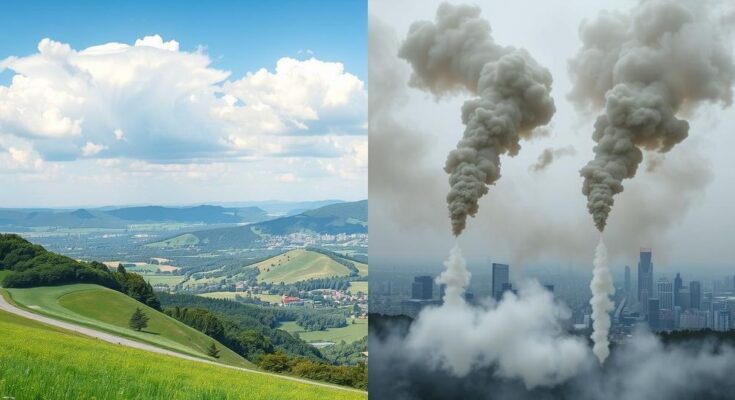In 2024, Chad and Bangladesh are the most polluted countries while Delhi is the most polluted capital. Only seven countries meet WHO air quality standards. A total of 74 out of the 100 most polluted cities are in India, which despite improvements, ranks fifth in global pollution. The report calls for better monitoring and regional cooperation, especially amidst the looming effects of U.S. monitoring cuts.
According to the 2024 World Air Quality report by Swiss-based IQAir, Chad and Bangladesh rank as the most polluted countries, while Delhi is identified as the most polluted capital. Alarmingly, only seven nations comply with the World Health Organization’s air quality guidelines. The report highlights the need for better pollution monitoring, particularly in Africa, where levels are often under-reported. This lack of data intensified following cuts to environmental protections under the Trump administration, leading to the closure of U.S. monitoring stations worldwide.
The report indicates that 74 of the 100 most polluted cities are located in India, reflecting a modest improvement from the previous year when 83 cities held this distinction. Nationally, India reported a 7% reduction in PM2.5 levels, averaging 50.6 micrograms per cubic meter, which still exceeds WHO’s safe level by tenfold. Despite this improvement, India ranks fifth globally in pollution after Chad, Bangladesh, Pakistan, and the Democratic Republic of Congo
Globally, a mere 17% of surveyed cities met the WHO air quality standard of 5 micrograms per cubic meter for PM2.5. The report illustrates that pollution persists mainly in the Global South, with Asia bearing the brunt. This year, 24 out of 54 African nations reported data, reflecting a significant advancement since only three countries contributed usable data in 2017.
The U.S. State Department’s recent decision to close air quality monitoring at embassies worldwide raised alarms regarding the implications for public health and air quality policies. Dr. Christi Chester Schroeder from IQAir emphasized that this closure could lead to a lack of real-time data in several developing countries, which is critical for monitoring pollution effectively.
Despite implementing a comprehensive air quality monitoring network, India’s national average remains comparatively lower than nations like Pakistan and Bangladesh, likely due to differences in monitoring scopes. Nevertheless, significant air pollution challenges persist in India and South Asia, particularly during seasonal spikes. Cooperation among neighboring countries is crucial, as air pollution transcends borders, impacting all regional stakeholders.
Delhi continues to struggle with severe air pollution, with PM2.5 levels climbing 6% to 108.3 micrograms per cubic meter, the highest since 2019. The report connects this increase to vehicular emissions and other contributing factors like industrial activities and agricultural burning. India’s northern plains remain the most polluted region, with the government looking to integrate pollution control efforts across state lines.
Remarkably, pollution within China has exhibited a decline in several cities, underscoring significant governmental endeavors to address air quality. However, Indonesia, while showing a decrease in pollution levels, faces challenges associated with its reliance on coal for energy. Concurrently, Vietnam has grappled with air quality costs on its GDP, and community efforts are underway to promote sustainable practices.
Lastly, the cleanest air identified in the report was in Honoka’a, Hawaii, with a remarkable average of one microgram of PM2.5 per cubic meter. It is clear that although strides are being made towards monitoring and improving air quality, significant work remains, particularly in more polluted regions of the globe.
The 2024 World Air Quality report reveals concerning trends in global air pollution, notably the dominance of South Asian countries like India, Bangladesh, and Pakistan among the most affected. The report emphasizes the urgent need for enhanced pollution monitoring and regional cooperation to tackle trans-boundary pollution issues. While advancements are noted in some areas, such as China, the ongoing challenges necessitate commitment and concrete actions to protect public health and ensure compliance with WHO air quality standards.
Original Source: healthpolicy-watch.news




